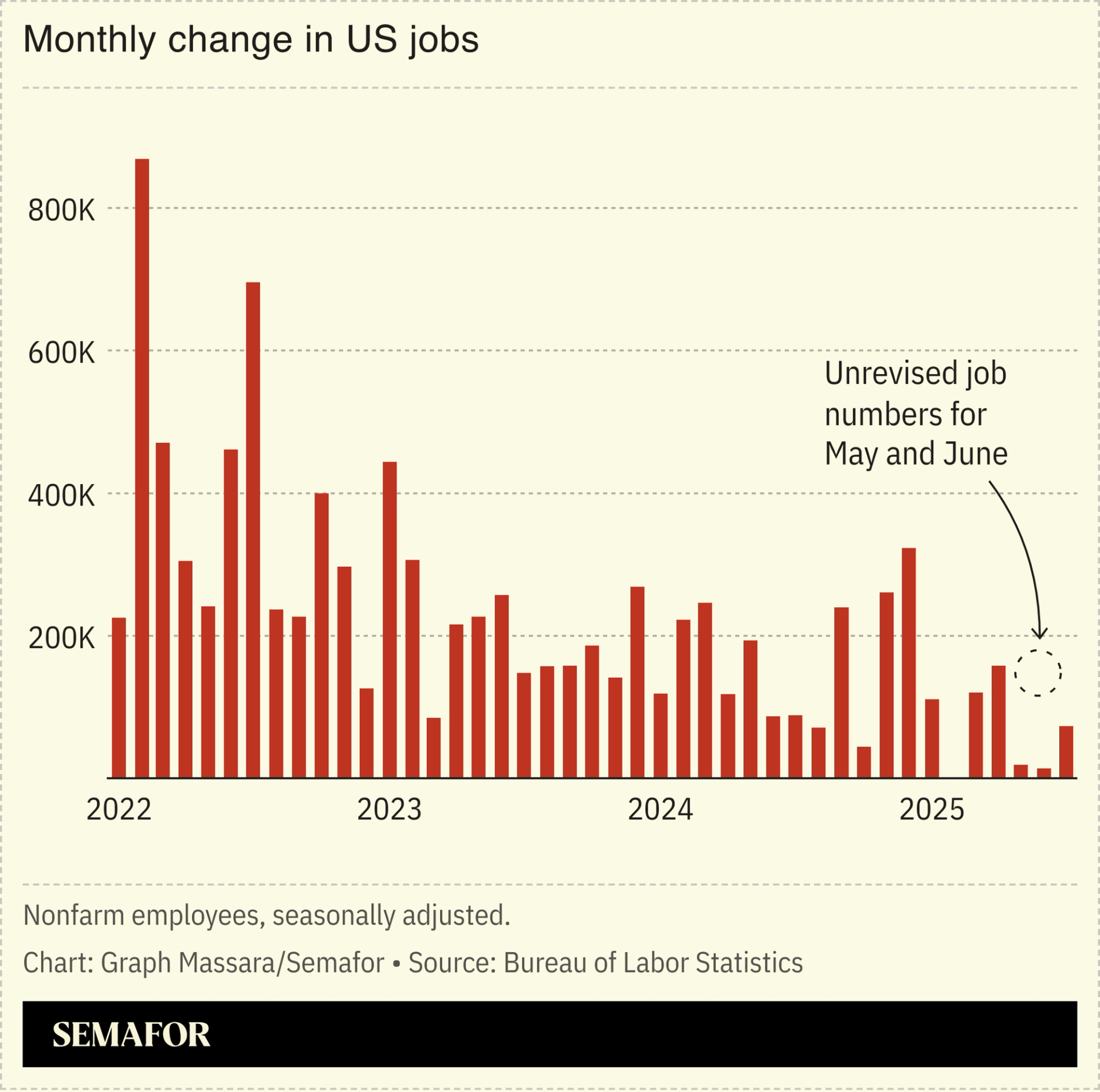The News
Investors are still reeling after a weaker-than-expected jobs report drove President Donald Trump to fire the head of the Bureau of Labor Statistics, undermining the perception of future economic data the Federal Reserve relies on to deliver the interest rate cuts he wants.
The anemic job gains in July, June, and May make it more likely the Fed will reduce borrowing costs at its September meeting, particularly as an early retirement creates an unexpected opening for Trump to fill — but Erika McEntarfer’s firing politicizes the data the central bank relies on.
“Navigation requires the right instruments, and jeopardizing the BLS’s output is akin to flying blind,” economist Kathryn Edwards told Semafor.
Already, some Republican lawmakers are pushing back — as is former Treasury Secretary Lawrence Summers, who said he doesn’t “see how serious members of the economics profession can stay in his administration.”
McEntarfer’s predecessor, who led BLS during Trump’s first administration, called the dismissal “without merit” and said it “undermines the credibility of federal economic statistics.” Staffing shortages and budget cuts at the agency had already raised questions about its ability to sustain the quality of its reports.
“This is pretty close to the most shocking thing he’s done yet, as far as economic policy goes,” Groundwork Collaborative’s Alex Jacquez, who served on the Biden administration’s National Economic Council, told Semafor.

Know More
Though the Fed sources some of the data it looks at from the private sector, Chair Jerome Powell last week described “government data” as “the gold standard,” which the Fed is “not going to be able to have a substitute for.”
Still, White House officials over the weekend defended the president’s decision.
“What we need is a fresh set of eyes over the BLS,” Kevin Hassett, the director of the National Economic Council, told NBC News’ Meet the Press. “There have been a bunch of patterns that could make people wonder.”
The accuracy of monthly jobs data had been a growing source of concern for the Fed even before Trump’s latest move. Fed Governor Christopher Waller — one of two officials to oppose the bank’s move last week to hold interest rates steady — in January 2024 complained that revisions to previous reports made the central bank’s job harder.
“Whatever data is released, that’s the data I have to use,” Waller said then. “The problem with data is it gets revised.”
The revisions themselves to BLS numbers can be a valuable signal, Harvard economist and former Obama economic adviser Jason Furman told Semafor last fall: “Historically, when you have an economy that is slowing, you get a lot of serial negative revisions, and when it’s speeding up, you get a lot of serial positive revisions.”
BLS revised data from May and June dramatically downward Friday, indicating that the labor market added far fewer jobs than reported at the time. BLS regularly revises previous reports as it collects additional information to provide a more complete picture of the economy — and those revisions are often much bigger when the economy is at an inflection point.
Yet both Hassett and Trump highlighted the agency’s latest revisions as especially notable.
A BLS spokesperson told Semafor in an email Friday that the seasonally adjusted revision to June’s jobs report “was largely the result of routine incorporation of additional/corrected sample that came in after the initial release.”
The spokesperson added that “the revision was concentrated within state and local government education components (contributing about 40 percent of the total revision), while the remaining revisions were widespread among other major industries.”
“Typically, monthly revisions have offsetting movements among major industries, but in June, most of the industry revisions were negative,” the spokesperson said.
Notable
- Revisions work both ways: “I remember talking to President Obama in 2015 or so, and we’d had, I think, 24 straight months of positive revisions, and he asked, ‘Why can’t we have the great number the day we announce it?’” Furman told Semafor.
Liz Hoffman contributed reporting.

